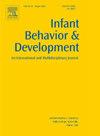A new screener predicts toddlers’ language development from age 2–3: The QUILS:TOD
IF 1.9
3区 心理学
Q3 PSYCHOLOGY, DEVELOPMENTAL
引用次数: 0
Abstract
Language interventions may yield greater benefits for younger children than their older counterparts, making it critical to evaluate children’s language skills as early as possible. Yet, assessing young children’s language presents many challenges, such as limited attention spans, low expressive language, and hesitancy to speak with an unfamiliar examiner. To address these challenges, the Quick Interactive Language Screener for Toddlers (QUILS:TOD; for children 24- to 36-months of age) was developed as a quick, tablet-based language screener capable of assessing children’s vocabulary, syntax, and word learning skills. We explored how children’s performance on the QUILS:TOD and the MacArthur-Bates Communicative Development Inventory, another language screener, at two years of age relates to their performance one year later on the Quick Interactive Language Screener (QUILS), a validated and normed screener for children between three and six years of age. Results revealed that performance on the QUILS:TOD was predictive of QUILS performance, highlighting the utility of the QUILS:TOD for identifying which children at age two would continue to lag behind their peers at age three. Lastly, although all QUILS:TOD areas (vocabulary, syntax, and word learning) were predictive of QUILS performance, the most robust predictor of children’s performance on the same receptive language dimensions at 3 years was their syntax, emphasizing the necessity of evaluating language beyond vocabulary.
一项新的测试可以预测2-3岁幼儿的语言发展:QUILS:TOD。
语言干预可能对年幼的孩子比年长的孩子产生更大的好处,因此尽早评估儿童的语言技能至关重要。然而,评估幼儿的语言存在许多挑战,例如注意力有限,语言表达能力低下,与不熟悉的考官说话时犹豫不决。为了应对这些挑战,针对幼儿的快速互动语言筛选器(QUILS:TOD;适用于24- 36个月大的儿童)是一种快速的、基于平板电脑的语言筛选器,能够评估儿童的词汇、语法和单词学习技能。我们探讨了儿童在两岁时在QUILS:TOD和麦克阿瑟-贝茨交际发展量表(另一种语言筛选器)上的表现与他们一年后在快速互动语言筛选器(QUILS)上的表现之间的关系,QUILS是一种针对3至6岁儿童的经过验证和规范的筛选器。结果显示,QUILS:TOD的表现可以预测QUILS:TOD的表现,突出了QUILS:TOD在确定哪些两岁的孩子在三岁时会继续落后于同龄人方面的效用。最后,尽管所有QUILS:TOD领域(词汇、句法和单词学习)都能预测QUILS的表现,但在3岁时,在相同的接受性语言维度上,最能预测儿童表现的是他们的句法,这强调了在词汇之外评估语言的必要性。
本文章由计算机程序翻译,如有差异,请以英文原文为准。
求助全文
约1分钟内获得全文
求助全文
来源期刊

Infant Behavior & Development
PSYCHOLOGY, DEVELOPMENTAL-
CiteScore
4.10
自引率
4.80%
发文量
94
期刊介绍:
Infant Behavior & Development publishes empirical (fundamental and clinical), theoretical, methodological and review papers. Brief reports dealing with behavioral development during infancy (up to 3 years) will also be considered. Papers of an inter- and multidisciplinary nature, for example neuroscience, non-linear dynamics and modelling approaches, are particularly encouraged. Areas covered by the journal include cognitive development, emotional development, perception, perception-action coupling, motor development and socialisation.
 求助内容:
求助内容: 应助结果提醒方式:
应助结果提醒方式:


